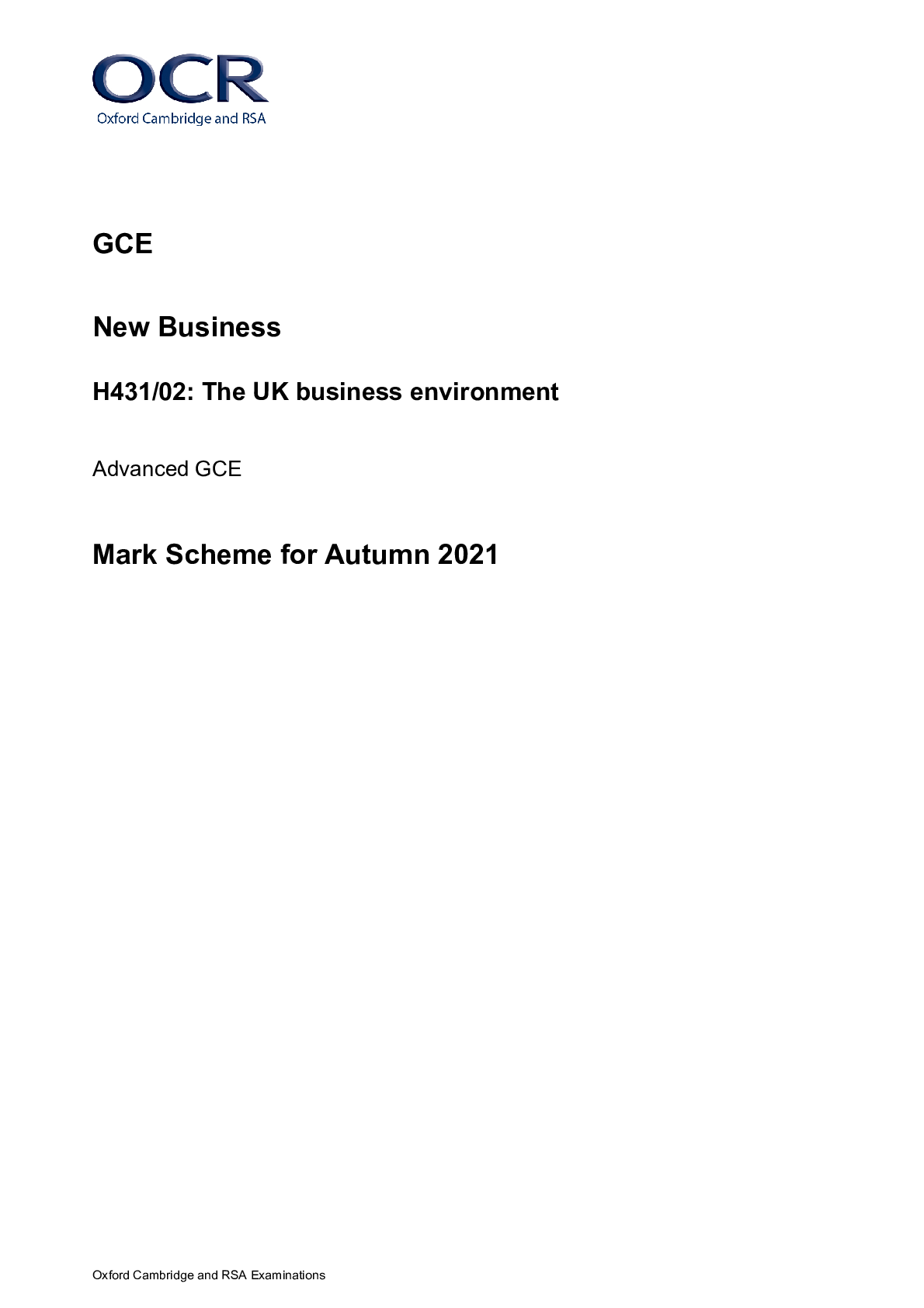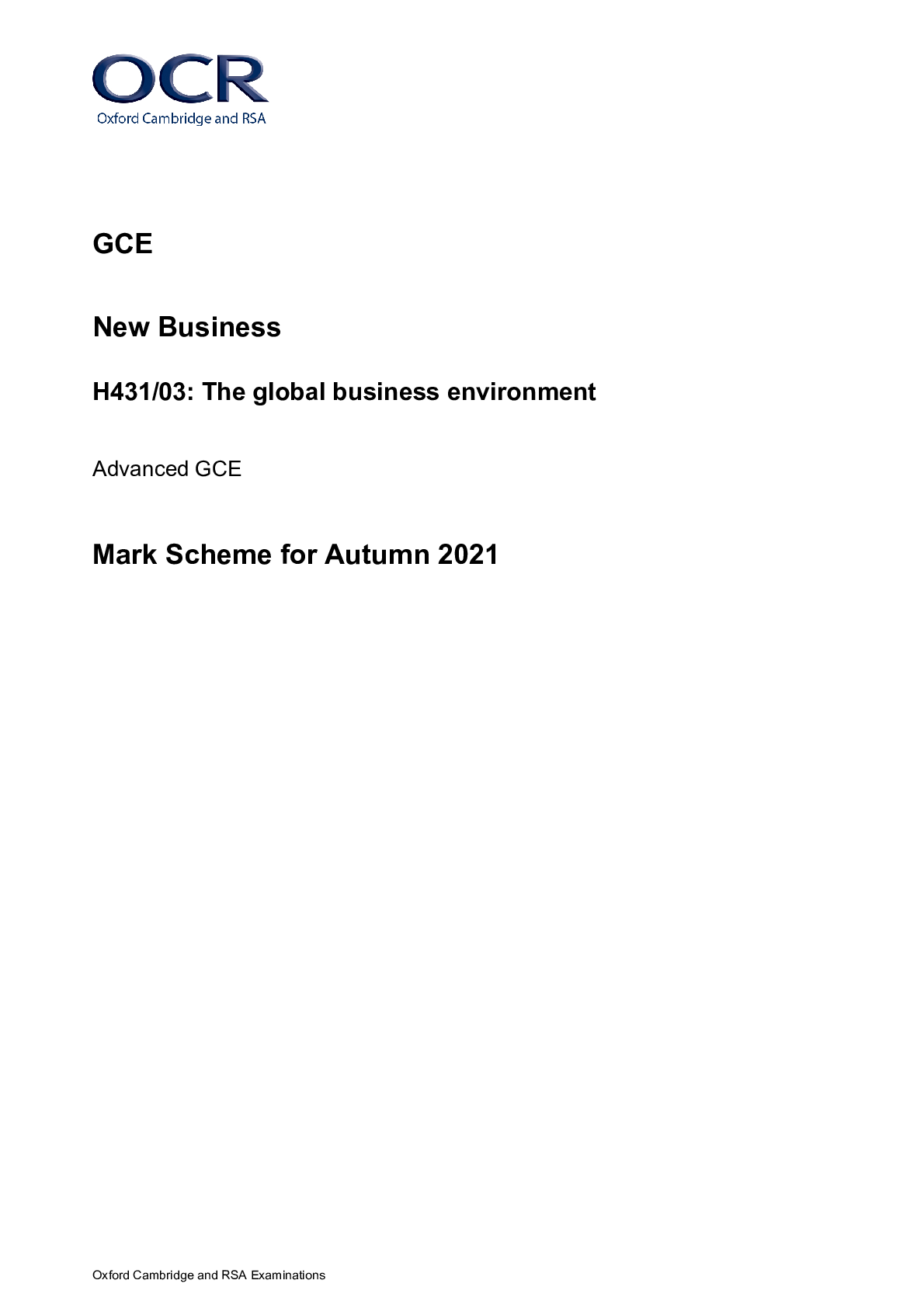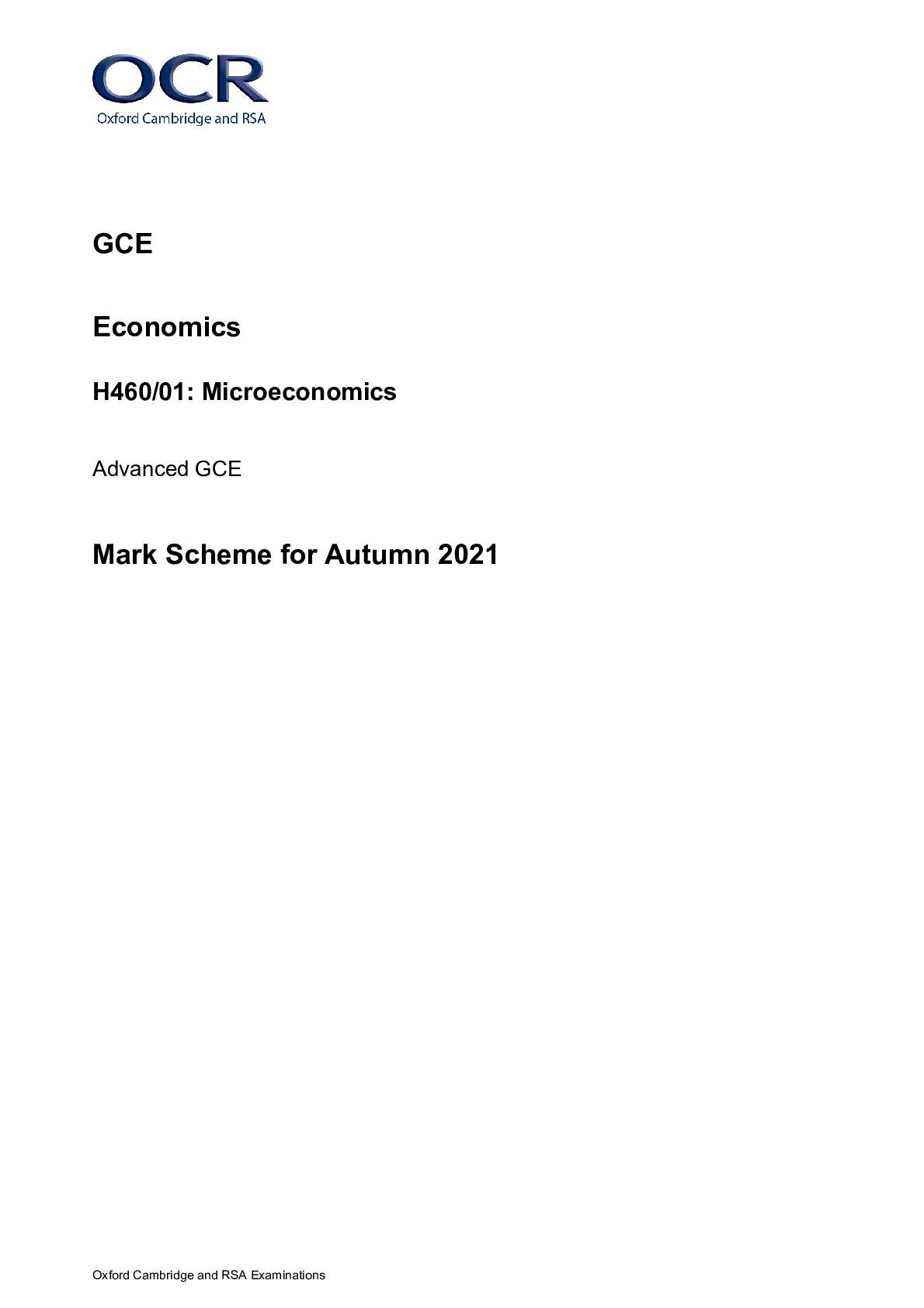Mathematics > MARK SCHEME > GCE Mathematics B (MEI) H640/02: Pure Mathematics and Statistics Advanced GCE Mark Scheme for Novemb (All)
GCE Mathematics B (MEI) H640/02: Pure Mathematics and Statistics Advanced GCE Mark Scheme for November 2020
Document Content and Description Below
GCE Mathematics B (MEI) H640/02: Pure Mathematics and Statistics Advanced GCE Mark Scheme for November 2020 Oxford Cambridge and RSA Examinations GCE Mathematics B (MEI) H640/02: Pure Math... ematics and Statistics Advanced GCE Mark Scheme for November 2020Oxford Cambridge and RSA Examinations OCR (Oxford Cambridge and RSA) is a leading UK awarding body, providing a wide range of qualifications to meet the needs of candidates of all ages and abilities. OCR qualifications include AS/A Levels, Diplomas, GCSEs, Cambridge Nationals, Cambridge Technicals, Functional Skills, Key Skills, Entry Level qualifications, NVQs and vocational qualifications in areas such as IT, business, languages, teaching/training, administration and secretarial skills. It is also responsible for developing new specifications to meet national requirements and the needs of students and teachers. OCR is a not-for-profit organisation; any surplus made is invested back into the establishment to help towards the development of qualifications and support, which keep pace with the changing needs of today’s society. This mark scheme is published as an aid to teachers and students, to indicate the requirements of the examination. It shows the basis on which marks were awarded by examiners. It does not indicate the details of the discussions which took place at an examiners’ meeting before marking commenced. All examiners are instructed that alternative correct answers and unexpected approaches in candidates’ scripts must be given marks that fairly reflect the relevant knowledge and skills demonstrated. Mark schemes should be read in conjunction with the published question papers and the report on the examination. © OCR 2020H640/02 Mark Scheme November 2020 2 Text Instructions Annotations and abbreviations Annotation in scoris Meaning and BOD Benefit of doubt FT Follow through ISW Ignore subsequent working M0, M1 Method mark awarded 0, 1 A0, A1 Accuracy mark awarded 0, 1 B0, B1 Independent mark awarded 0, 1 E Explanation mark 1 SC Special case ^ Omission sign MR Misread BP Blank page Highlighting Other abbreviations in mark scheme Meaning E1 Mark for explaining a result or establishing a given result dep* Mark dependent on a previous mark, indicated by *. The * may be omitted if only previous M mark. cao Correct answer only oe Or equivalent rot Rounded or truncated soi Seen or implied www Without wrong working AG Answer given awrt Anything which rounds to BC By Calculator DR This indicates that the instruction In this question you must show detailed reasoning appears in the question.H640/02 Mark Scheme November 2020 17 Subject-specific Marking Instructions for AS Level Mathematics B (MEI) a Annotations must be used during your marking. For a response awarded zero (or full) marks a single appropriate annotation (cross, tick, M0 or ^) is sufficient, but not required. For responses that are not awarded either 0 or full marks, you must make it clear how you have arrived at the mark you have awarded and all responses must have enough annotation for a reviewer to decide if the mark awarded is correct without having to mark it independently. It is vital that you annotate standardisation scripts fully to show how the marks have been awarded. Award NR (No Response) - if there is nothing written at all in the answer space and no attempt elsewhere in the script - OR if there is a comment which does not in any way relate to the question (e.g. ‘can’t do’, ‘don’t know’) - OR if there is a mark (e.g. a dash, a question mark, a picture) which isn’t an attempt at the question. Note: Award 0 marks only for an attempt that earns no credit (including copying out the question). If a candidate uses the answer space for one question to answer another, for example using the space for 8(b) to answer 8(a), then give benefit of doubt unless it is ambiguous for which part it is intended. b An element of professional judgement is required in the marking of any written paper. Remember that the mark scheme is designed to assist in marking incorrect solutions. Correct solutions leading to correct answers are awarded full marks but work must not always be judged on the answer alone, and answers that are given in the question, especially, must be validly obtained; key steps in the working must always be looked at and anything unfamiliar must be investigated thoroughly. Correct but unfamiliar or unexpected methods are often signalled by a correct result following an apparently incorrect method. Such work must be carefully assessed. When a candidate adopts a method which does not correspond to the mark scheme, escalate the question to your Team Leader who will decide on a course of action with the Principal Examiner. If you are in any doubt whatsoever you should contact your Team Leader.H640/02 Mark Scheme November 2020 18 c The following types of marks are available. M A suitable method has been selected and applied in a manner which shows that the method is essentially understood. Method marks are not usually lost for numerical errors, algebraic slips or errors in units. However, it is not usually sufficient for a candidate just to indicate an intention of using some method or just to quote a formula; the formula or idea must be applied to the specific problem in hand, e.g. by substituting the relevant quantities into the formula. In some cases the nature of the errors allowed for the award of an M mark may be specified. A method mark may usually be implied by a correct answer unless the question includes the DR statement, the command words “Determine” or “Show that”, or some other indication that the method must be given explicitly. A Accuracy mark, awarded for a correct answer or intermediate step correctly obtained. Accuracy marks cannot be given unless the associated Method mark is earned (or implied). Therefore M0 A1 cannot ever be awarded. B Mark for a correct result or statement independent of Method marks. E A given result is to be established or a result has to be explained. This usually requires more working or explanation than the establishment of an unknown result. Unless otherwise indicated, marks once gained cannot subsequently be lost, e.g. wrong working following a correct form of answer is ignored. Sometimes this is reinforced in the mark scheme by the abbreviation isw. However, this would not apply to a case where a candidate passes through the correct answer as part of a wrong argument. d When a part of a question has two or more ‘method’ steps, the M marks are in principle independent unless the scheme specifically says otherwise; and similarly where there are several B marks allocated. (The notation ‘dep*’ is used to indicate that a particular mark is dependent on an earlier, asterisked, mark in the scheme.) Of course, in practice it may happen that when a candidate has once gone wrong in a part of a question, the work from there on is worthless so that no more marks can sensibly be given. On the other hand, when two or more steps are successfully run together by the candidate, the earlier marks are implied and full credit must be given. e The abbreviation FT implies that the A or B mark indicated is allowed for work correctly following on from previously incorrect results. Otherwise, A and B marks are given for correct work only – differences in notation are of course permitted. A (accuracy) marks are not given for answers obtained from incorrect working. When A or B marks are awarded for work at an intermediate stage of a solution, there may be various alternatives that are equally acceptable. In such cases, what is acceptable will be detailed in the mark scheme. If this is not the case, please escalate the question to your Team Leader who will decide on a course of action with the Principal Examiner. Sometimes the answer to one part of a question is used in a later part of the same question. In this case, A marks will often be ‘follow through’. In such cases you must ensure that you refer back to the answer of the previous part question even if this is not shown within the image zone. You may find it easier to mark follow through questions candidate-by-candidate rather than question-by-question.H640/02 Mark Scheme November 2020 17 f Unless units are specifically requested, there is no penalty for wrong or missing units as long as the answer is numerically correct and expressed either in SI or in the units of the question. (e.g. lengths will be assumed to be in metres unless in a particular question all the lengths are in km, when this would be assumed to be the unspecified unit.) We are usually quite flexible about the accuracy to which the final answer is expressed; over-specification is usually only penalised where the scheme explicitly says so. • When a value is given in the paper only accept an answer correct to at least as many significant figures as the given value. • When a value is not given in the paper accept any answer that agrees with the correct value to 2 s.f. unless a different level of accuracy has been asked for in the question, or the mark scheme specifies an acceptable range. NB for Specification A the rubric specifies 3 s.f. as standard, so this statement reads “3 s.f” Follow through should be used so that only one mark in any question is lost for each distinct accuracy error. Candidates using a value of 9.80, 9.81 or 10 for g should usually be penalised for any final accuracy marks which do not agree to the value found with 9.8 which is given in the rubric. g Rules for replaced work and multiple attempts: • If one attempt is clearly indicated as the one to mark, or only one is left uncrossed out, then mark that attempt and ignore the others. • If more than one attempt is left not crossed out, then mark the last attempt unless it only repeats part of the first attempt or is substantially less complete. • if a candidate crosses out all of their attempts, the assessor should attempt to mark the crossed out answer(s) as above and award marks appropriately. h For a genuine misreading (of numbers or symbols) which is such that the object and the difficulty of the question remain unaltered, mark according to the scheme but following through from the candidate’s data. A penalty is then applied; 1 mark is generally appropriate, though this may differ for some units. This is achieved by withholding one A or B mark in the question. Marks designated as cao may be awarded as long as there are no other errors. If a candidate corrects the misread in a later part, do not continue to follow through. E marks are lost unless, by chance, the given results are established by equivalent working. Note that a miscopy of the candidate’s own working is not a misread but an accuracy error. i If a calculator is used, some answers may be obtained with little or no working visible. Allow full marks for correct answers provided that there is nothing in the wording of the question specifying that analytical methods are required such as the bold “In this question you must show detailed reasoning”, or the command words “Show” and “Determine. Where an answer is wrong but there is some evidence of method, allow appropriate method marks. Wrong answers with no supporting method score zero. If in doubt, consult your Team Leader. j If in any case the scheme operates with considerable unfairness consult your Team Leader.H640/02 Mark Scheme November 2020 18 Question Answer Marks AOs Guidance 1 ½ × 22.1× 18.0 × sin133˚ 14 5 cao M1 A1 [2] 1.1a 1.1 or ½ × 18.0 × 36.8× sin26˚ or ½ × 22.1 × 36.8× sin21˚ ignore units NB 172.8 or 173 unsupported implies M1 2 (a) 16.8 or 17 cao B1 [1] 1.1 ignore units 2 (b) 1 2 × 82 × 2.1 67.2 or 67 cao M1 A1 [2] 1.1a 1.1 or �° 360 × � × 8² ignore units θ = 120 – 120.3211… 3 (a) 4 + 8cos8x M1* A1 [2] 1.1 1.1 differentiation with either term correct all correct 3 (b) attempt to solve their 4 + 8cos8x = 0 � 12 isw cao M1dep * A1 [2] 1.1 1.1 one intermediate step seen 4 (a) 23 ≤ m ≤ 29 B1 [1] 1.1 4 (b) no, p% spent less than an hour revising maths; or no, 90% spent less than m minutes revising maths B1 [1] 2.4 75 ≤ p ≤ 85 75 ≤ m ≤ 100 Allow eg x out of 200 is not 90% or 0.9 oe where 150 ≤ x ≤ 170H640/02 Mark Scheme November 2020 17 Question Answer Marks AOs Guidance 5 (a) 26 B1 [1] 1.1 NB 17 + (n ‒ 1) × 11 = 292 5 (b) �ℎ��� 26 2 × (17 + 292) oe 4017 M1 A1 [2] 1.1 1.1 �ℎ��� 26 2 × (2 × 17 + (�ℎ��� 26 − 1) × 11) 6 (a) 1 + �1 2� (4�) + �1 2� �− 1 2� (42�!)2 isw cao M1 A1 A1 [3] 2.1 1.1 1.1 ignore extra terms, allow one error two of three terms correct all three terms correct, ignore extra terms if M0 allow SC2 for 2 of first three terms correct 6 (b) oe B1 [1] 1.1 or |�| ≤ ¼ oe 7 (a) 0.6 + 0.5 − P(� ∩ �) = 1 − 0.2 oe soi = 0.3 M1 A1 [2] 1.1a 1.1 or M1 for probabilities in bold correct in table or marked correctly on Venn diagram NB 0.3 from 0.6×0.5 does not score A ~� B 0.3 0.2 0.5 ~� 0.3 0.2 0.5 0.6 0.4 1 7 (b) 0.3 0.5 = 0.6 M1 A1 [2] 1.1 1.1 their P(�∩�) 0 .5 2 1 2 2 + − x x 14 x <H640/02 Mark Scheme November 2020 18 Question Answer Marks AOs Guidance 7 (c) independent since p(A) = p(A/B) oe B1 [1] 2.4 or 0.6×0.5 = 0.3 or P(A∩B) = P(A) × P(B) FT their values with correct argument 8 (a) Quota sampling B1 [1] 1.2 8 (b) 9 B1 [1] 1.1 from 5 × 1.8 8 (c) Systematic: select every 24th number on the list start randomly between n = 1 and n ≥ 184 and stop when 200 have been selected (if n > 184, must cycle through list) Simple random sampling: assign each item in the list a unique number (eg from 1 to 4960) generate random numbers until a sample of 200 has been selected soi M1 A1 E1 E1 [4] 2.4 1.1 2.4 1.1 alternatively select every 25th number on the list start randomly between n = 1 and n ≥ 25, and cycle through the list again, stopping when 200 have been selected alternatively allow any process where each member of the population has an equal chance of being selected allow any process where each possible sample has an equal chance of being selected alternatively select every 24.8th value on list, rounding as appropriate start randomly with any value on list. Cycle through the list repeatedly until 200 items have been selectedH640/02 Mark Scheme November 2020 17 Question Answer Marks AOs Guidance 8 (d) as the size of the sample increases, the shape of the distribution appears more and more “Normal” oe B1 [1] 2.4 must refer to shape and closer to Normal shape for larger sample 8 (e) use of N(60.0515, 6.57832) to find P(X > 65) awrt 0.23 4960 × their 0.226 1121 or 1120 or 1119 M1 A1 M1 A1 [4] 3.3 3.4 3.1b 3.5a condone use of 6.57172 or parameters rounded to 3 sf M0 if continuity correction used or eg P(X > 64) found 8 (f) eg there may be seasonal fluctuations such as teachers retiring in August B1 [1] 3.5b allow any sensible reason in context do not allow eg mean and sd may be different 9 (a) eg randomly select N different businesses and then randomly select P computers from each business; may be implied by correct description B1 [1] 2.4 N × P = 120 where N and P are integers greater than 1. eg 20 and 6 or 15 and 8H640/02 Mark Scheme November 2020 18 Question Answer Marks AOs Guidance 9 (b) H0: μ = 5 oe H1: μ ≠ 5 oe H1 takes this form as Claud is testing whether the mean length of time is different to 5 oe μ is the population mean time for which computers are kept before being replaced use of N(5, 2.7054² 120 ) to find P(�� < 4.8855) or invNorm(p,5, 2√.7054 120 ) where p = 0.025 or 0.05; may be implied by 0.3215 or 4.51595…or 4.59377… P(��< 4.8855) = awrt 0.32 0.32 > 0.025 or 4.8855 > 4.5(2) not significant or accept H0 or do not reject H0 or reject H1 insufficient evidence to suggest (at 5% level) that the (population) mean length of time (computers are kept) is not 5 years B1 B1 B1 M1 A1 M1 A1FT A1FT [8] 1.1 2.4 2.5 3.3 1.1 3.4 1.1 2.2b allow any parameter apart from �̅ for population mean as long as clearly defined as (population) mean condone use of 2.6941 (may be rounded) instead of 2.7054 for M1, may be implied by 0.32076 or CR is �� < 4.51797.. , but A1 not available or CR is (��) < 4.5 − 4.6 comparison of their probability with 0.025 or comparison of 4.8855 with their critical value from use of 0.025, as long as previous M1 awarded may be embedded in conclusion in context after B marks M1A1M1A1A1 may be earned if working with 2.7054 rounded to 2 or more sf or z = 4.8855 ‒5 2.7054 √120 for M1 awrt ‒ 0.46 A1 (may be implied by ‒0.466 or ‒0.465567.. if 2.6941 used) their ‒ 0.4436 > ‒ 1.96 oe M1 dep on award of previous M1 do not allow eg conclude / prove / indicate or other assertive statement instead of suggest; A0 if answer spoiledH640/02 Mark Scheme November 2020 17 Question Answer Marks AOs Guidance 10 (a) sin2x ≈ 2x or sinx ≈ x used ∫ �1 �� d� or ∫�1 � − �� d� obtained oe nfww F[x] = lnx oe or F[x] = lnx ‒ ½ x² oe ln(0.05) ‒ ln(0.01) = ln5 oe or ln(0.05) ‒ ln(0.01) + 0.0012 ≈ ln5 oe M1 A1 A1 A1 [4] 3.1a 1.1 1.1 3.2a may see cos� ≈ 1 − �2 2 intermediate step needed from here to earn final mark 10 (b) differentiation of their 1 � substitution of 0.01 and ‒ 10 000 correctly obtained M1 A1 [2] 2.1 1.1 or differentiation of y using quotient rule and use of small angle approximation from − 1 �2 or − 1 2� − 1 oe 10 (c) 4.54066 × 10‒6 or 0.00000454066 cao (no sign change for 6 dp), but sign change for 5 dp or last two iterates agree to 5dp 0.94775 B1 E1 B1 [3] 2.5 3.1a 3.2a allow sign change between 0.947745 and 0.9477475H640/02 Mark Scheme November 2020 18 Question Answer Marks AOs Guidance 11 (a) house prices are generally higher in London boroughs (than elsewhere in the country), so Dr Procter’s suggestion is probably wrong B1 [1] 2.2a 11 (b) 214 505 219 402 B1 B1 [2] 3.4 1.1 11 (c) P = 28 500Y ‒ 57 184 000 (where Y is the calendar year) or P = 28 500y + 215 000 (where y is the number of years after 2014) B1 B1 [2] 3.3 1.1 gradient intercept allow both marks for correct equation in any form isw allow eg y = 28 500x ‒ 57 184 000 11 (d) 2016 272 000 2017 300 500 B1 B1 [2] 3.4 1.1 FT their straight line model provided this gives values > 250 000 11 (e) Dr Procter’s model is a (very) poor fit Prof Jackson’s is a good fit, or works well for 2017, but not 2016 B1 B1 [2] 2.2a 2.2a dependent on correct values in (b) FT comment for their values > 250 000 this mark is dependent on having calculated values in part (d) 11 (f) neither – extrapolation oe B1 [1] 3.5bH640/02 Mark Scheme November 2020 17 Question Answer Marks AOs Guidance 12 (a) 2p + q + 0.2 + 0.3 = 1 soi oe 2 × p × q = 0.06 soi eliminate p or q with a correct substitution from one of their equations q2 ‒ 0.5q + 0.06 = 0 or 2p2 ‒ 0.5p + 0.03 = 0 oe q = 0.2 or 0.3 and p = 0.15 or 0.1 (q < 2p so) q = 0.2 and p = 0.15 B1 M1 M1 A1 A1 A1 [6] 2.1 3.1a 1.1 1.1 1.1 3.2a allow M1 if 2 omitted eg 2 × 0.03 � + q = 0.5 or 2p + 0.03 � = 0.5 may be implied by eg q = 0.2 or 0.3 and 2p = 0.3 or 0.2 NB if 2 omitted, A0 for 2�2 − 0.5� + 0.6 = 0 or 2�2 + � + 0.24 = 0 which have no real roots 12 (b) 10×q×(1 ‒ q)9 soi 0.27 or 0.268 or awrt 0.2684 isw M1 A1 [2] 1.1 1.1 FT their q where 0 < q < 1H640/02 Mark Scheme November 2020 18 Question Answer Marks AOs Guidance 12 (c) H0: p = 0.2 H1: p > 0.2 p is the probability that the spinner shows a 1 (on any given spin) oe use of X ~ B(100,0.2) where x is the number of 1s obtained in 100 spins to obtain P(X ≥ k) or P(X ≤ k) P(X ≤ 27) = awrt 0.97 or P(X ≥ 28) = awrt 0.034 0.034 < 0.05 or 0.97 > 0.95 significant or reject H0 or accept H1; may be embedded in conclusion in context there is sufficient evidence to suggest (at 5% level) that the probability of a score of 1 is greater than 0.2 B1 B1 M1 A1 M1 A1 A1 [7] 1.1 2.5 3.3 1.1 3.4 1.1 2.2b both hypotheses; allow equivalent in words or eg P(1) = 0.2 k = 27, 28 or 29 or critical region is X ≥ 28 or 28 is in critical region must have the correct probability or correct critical region for the last two A marks allow any parameter as long as clearly defined as probability M0 for P(X = k) NB P(X = 28) = 0.014… P(X = 27) = 0.020168… FT their probability, dependent on award of first M1 do not allow eg conclude / prove / indicate or other assertive statement instead of suggest; A0 if answer spoiled 13 (a) Lee is wrong because he should make the comparison of 0.033 with 0.05 he should make the comparison of 0.37154 with 0 B1 B1 [2] 2.2a 2.2b allow he should have compared r with the critical value if B0B0 SC1 for Lee has confused r with p or for 0.37154 suggests positive correlationH640/02 Mark Scheme November 2020 17 Question Answer Marks AOs Guidance 13 (b) 465467 + 2×204356 awrt 874180 (or 867940 from use of 210236) from scatter diagram the outliers are approximately 920 000, 1 200 000 M1 A1 [2] 2.1 2.2b condone use of 201236 instead of 204356; ignore work relating to lower tail numerical values must be mentioned or 521000 + 1.5 × (521000 ‒ 342500) or 788750 in which case accept two or three outliers identified extra one is approximately 800 000 13 (c) the pmcc would (probably) be closer to 0 because the scatter is less well modelled by a straight line the p-value would increase because a value which is closer to 0 is more likely assuming there is no correlation B1 B1 [2] 2.2b 2.2b if B0B0 allow SC1 for r closer to 0 and p-value larger 13 (d ) the student’s suggestion is reasonable, since there are other regions defined in the LDS B1 [1] 2.2bH640/02 Mark Scheme November 2020 18 Question Answer Marks AOs Guidance 14 oe x = � 18 and x = 5� 18 ± ∫�sin�cos2� − �1 2 − sin2�cos��� d� oe F[5� 18 ] ‒ F[ � 18 ] √3 3 − � 9 or 3√3−� 9 cao M1 M1 A1 A1 M1 A1 M1 A1 [8] 3.1a 2.1 3.2a 1.1 1.1 1.1 1.1 3.2a from compound angle formula allow sign errors only A1 for each ignore limits allow the positive of this F[x] must be one of the correct forms or 4sin3� − 3sin� + ½ = 0 oe 0.17453… A1 0.87266… A1 to 2 or more sf ± �− 4 3 cos3� + cos� − � 2� oe or ±(−⅓cos2�cos� + ⅓sin�sin2� − ½�) oe for A1 F[0.87266] ‒ F[0.17453] for M1 1 sin 2 cos sin cos 2 2 − = x x x x 1 sin 3 2 x = cos 3 F[ ] 2 3 x x x = − −H640/02 Mark Scheme November 2020 17 Question Answer Marks AOs Guidance 15 (a) [h(�) �� fg(�) =] √�3 − � − 6 oe x > 2 B1 B1 [2] 1.1 1.1 expression domain mark the final answer 15 (b) √18 oe isw FT their h(x) B1 [1] 1.1 allow 4.2426406872… rounded to 2 or more sf 15 (c) ½× 3�²‒1 �(�3‒�−6) or 3�²‒1 2h(�) oe their dℎ �� evaluated at x = 3 3√2 13 or 0.326356975932 rounded to 2 sf or better M1 A1 M1 A1 [4] 3.1a 1.1 1.1 3.2a chain rule used all correct allow one slip in differentiation, eg sign error h(x) must be correct for first M1 OR �2 = �3 − � − 6 ⟹ 2� �� �� = 3�2 − 1 oe �� �� = 3�2−1 2� or �� �� = 2� 3�2−1 substitution of y = 3 and x = their √18 3√2 13 or 0.326356975932 rounded to 2 sf or better M1 A1 M1 A1 [4] allow one slip eg sign error rearrangement to find h‒1(x) explicitly in terms of x followed by differentiation does not scoreOCR (Oxford Cambridge and RSA Examinations) The Triangle Building Shaftesbury Road Cambridge CB2 8EA [Show More]
Last updated: 1 year ago
Preview 1 out of 19 pages

Buy this document to get the full access instantly
Instant Download Access after purchase
Add to cartInstant download
We Accept:

Reviews( 0 )
$7.50
Document information
Connected school, study & course
About the document
Uploaded On
Oct 07, 2022
Number of pages
19
Written in
Additional information
This document has been written for:
Uploaded
Oct 07, 2022
Downloads
0
Views
34


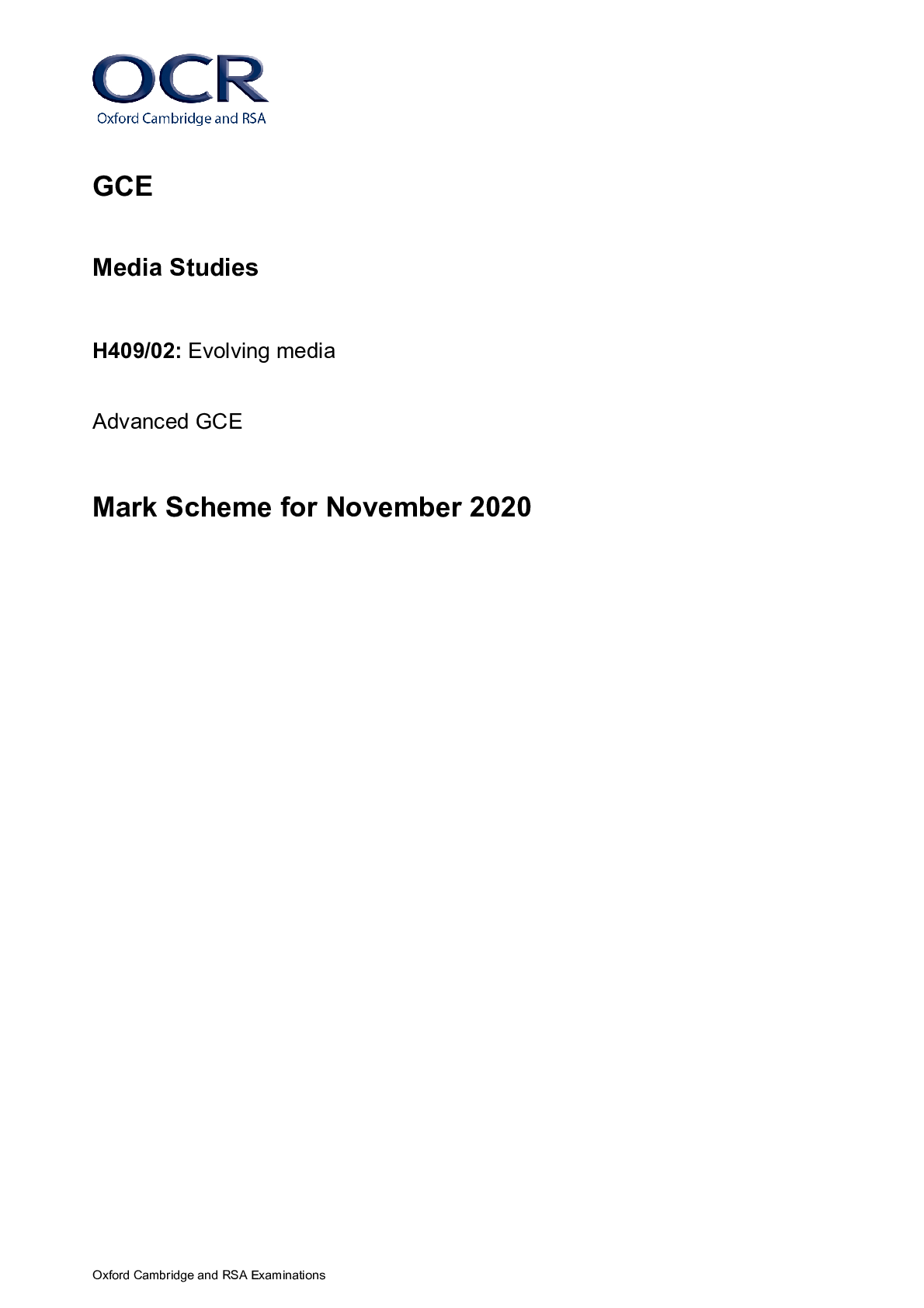
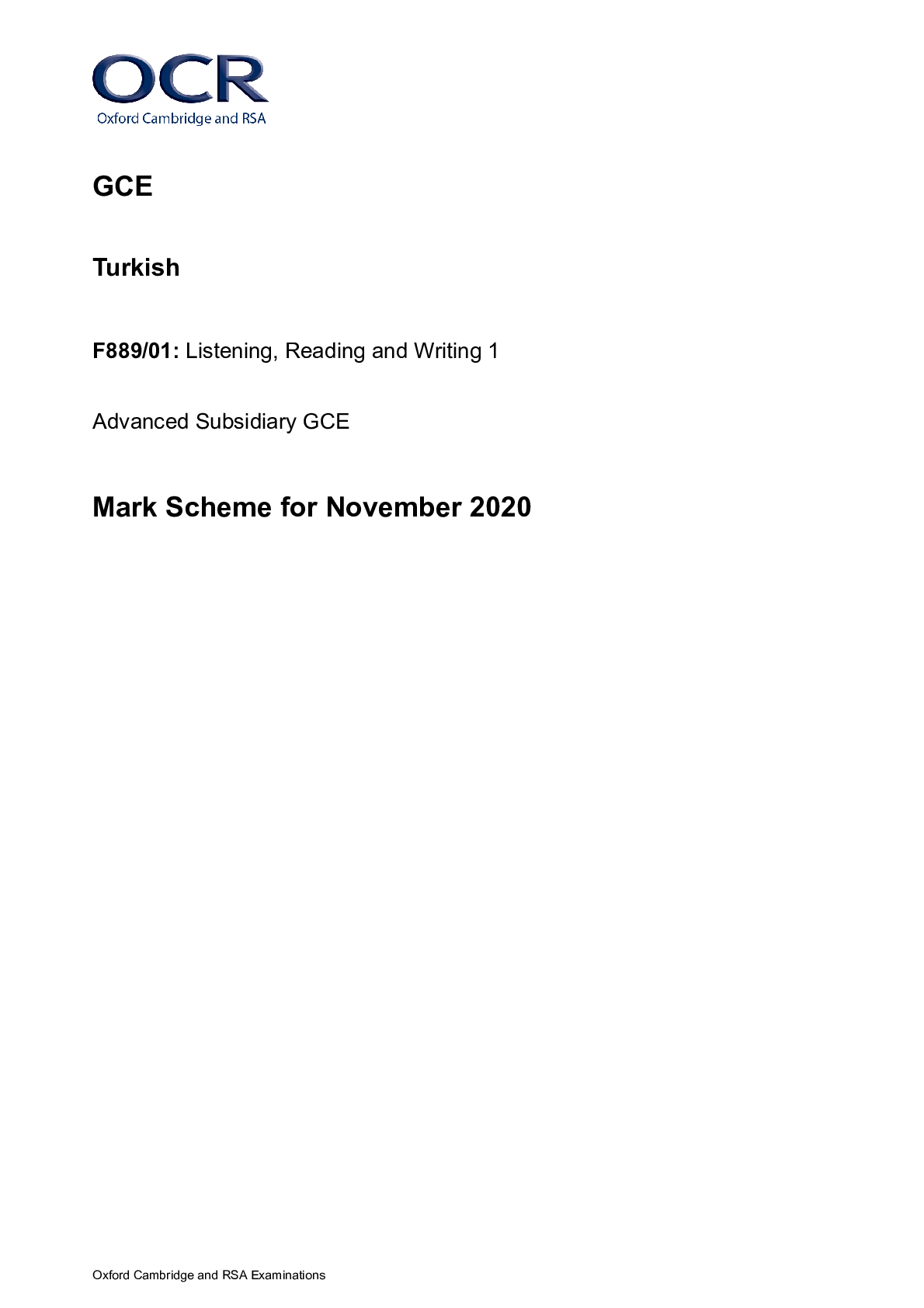
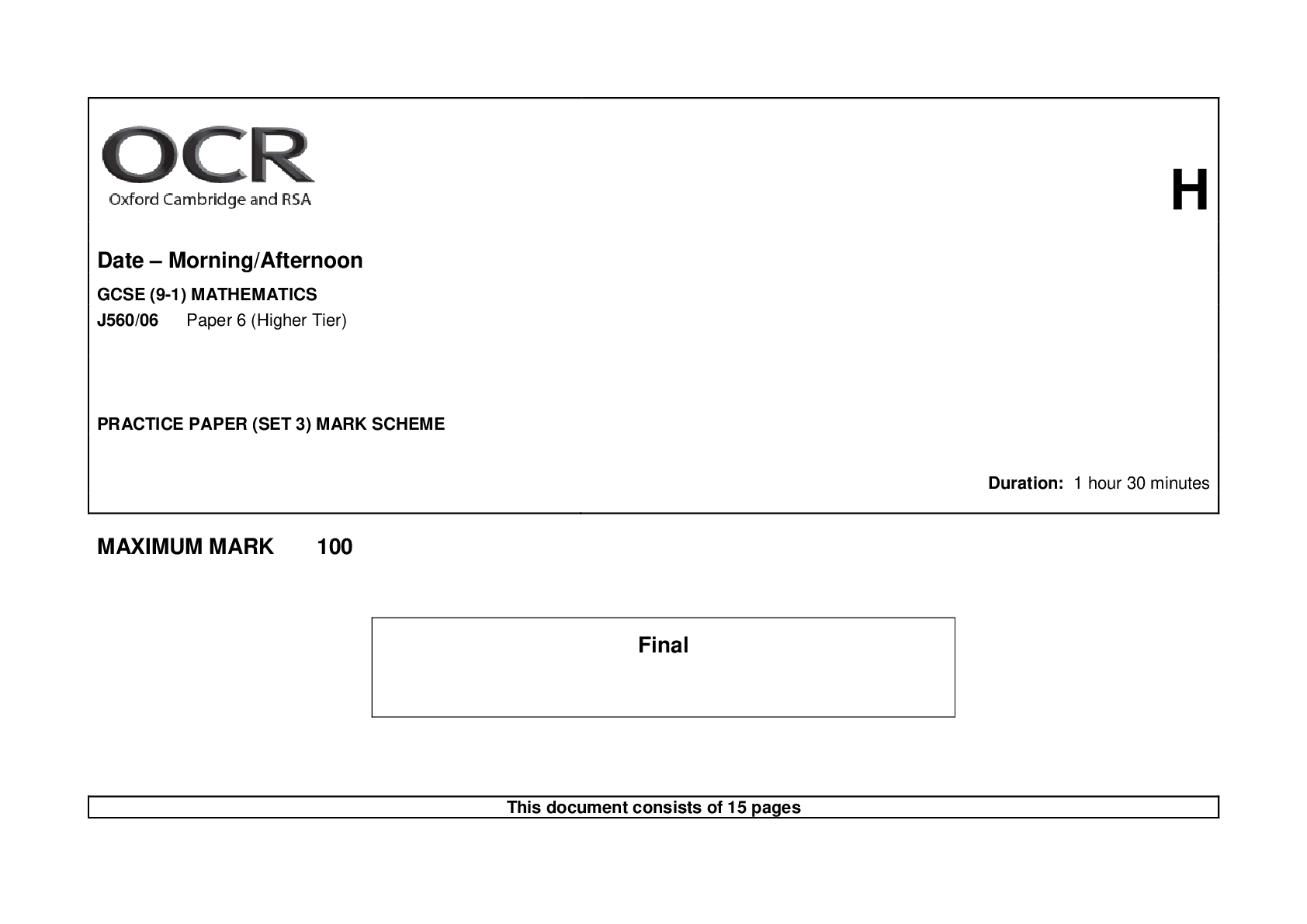


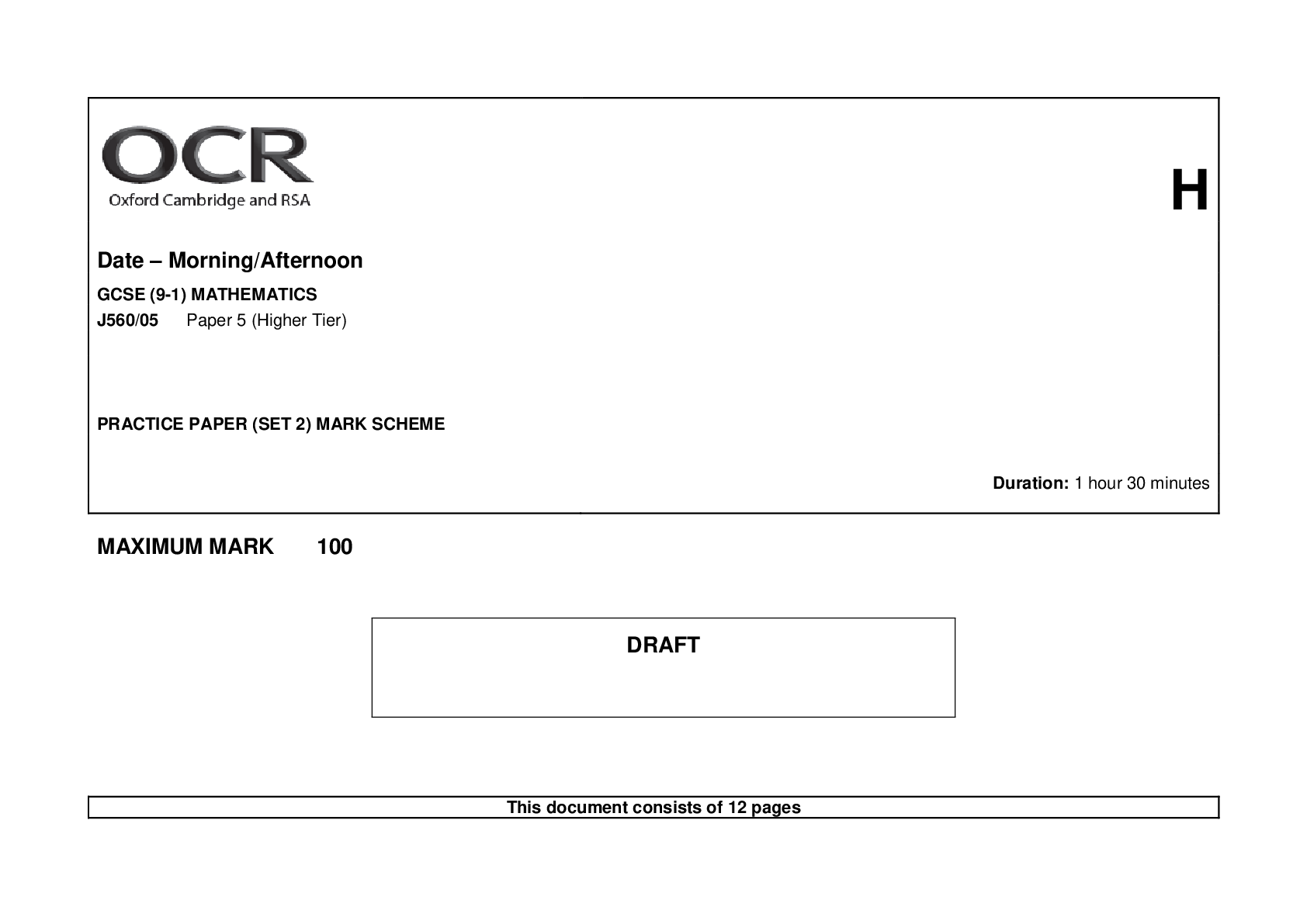
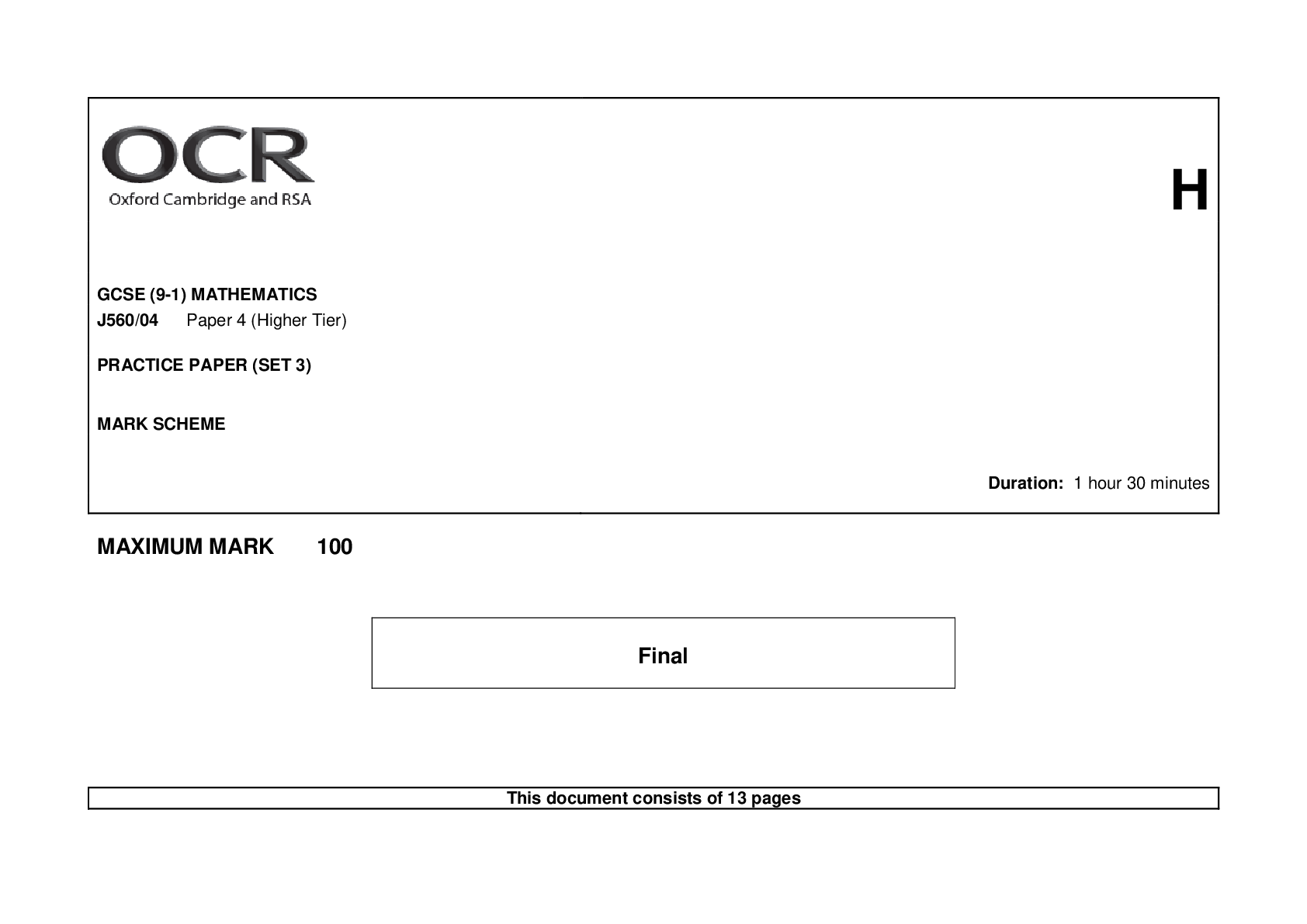



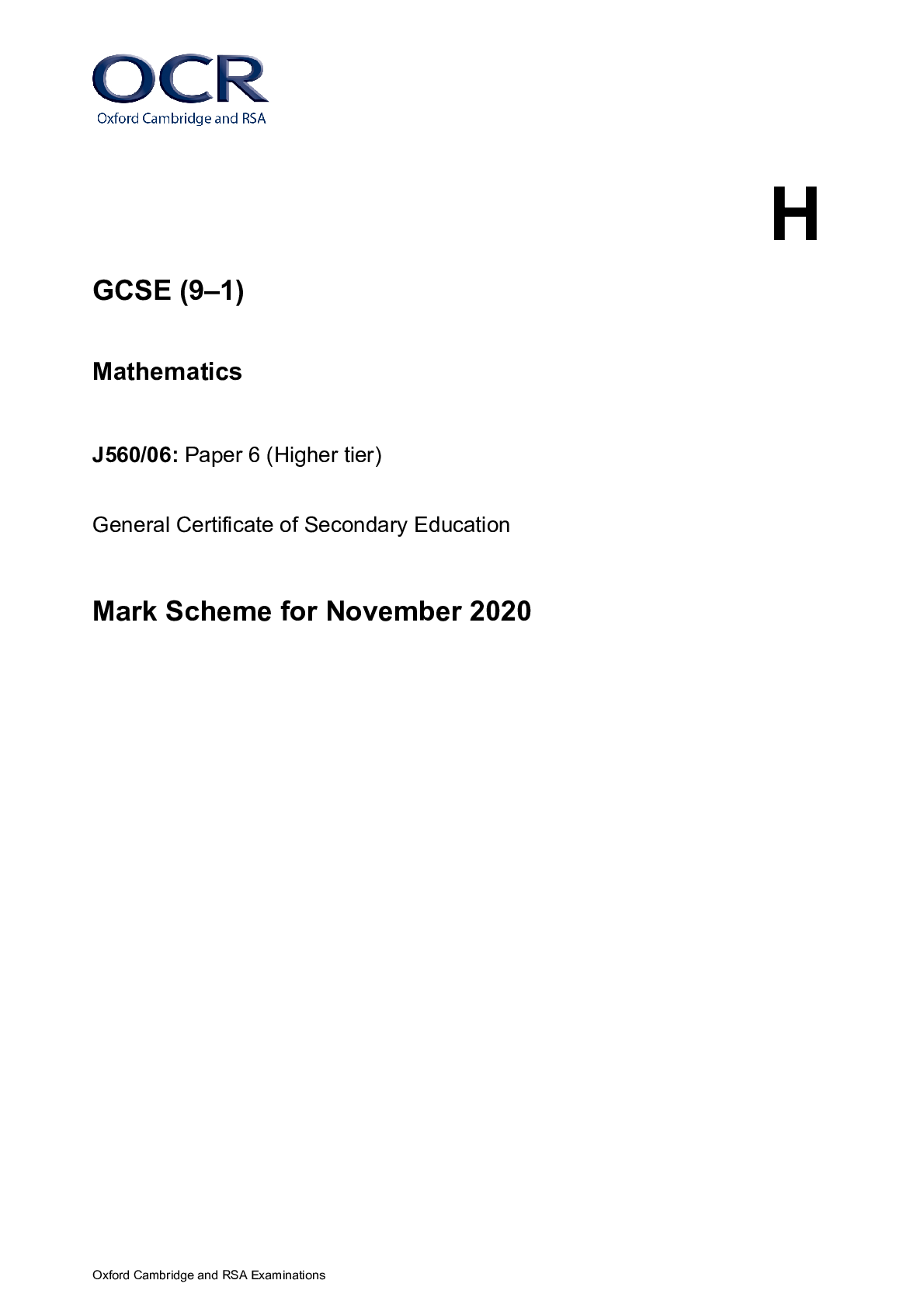
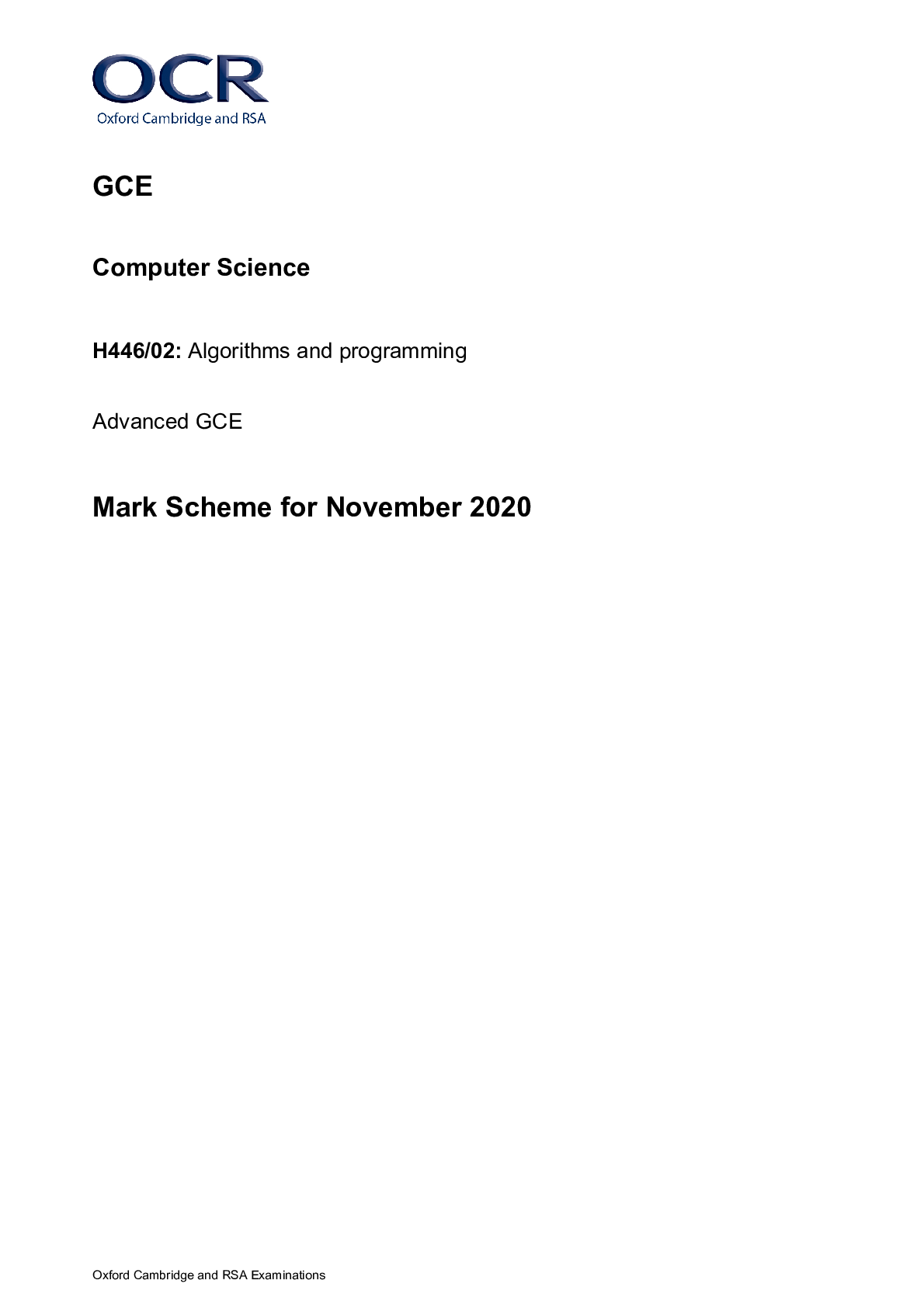
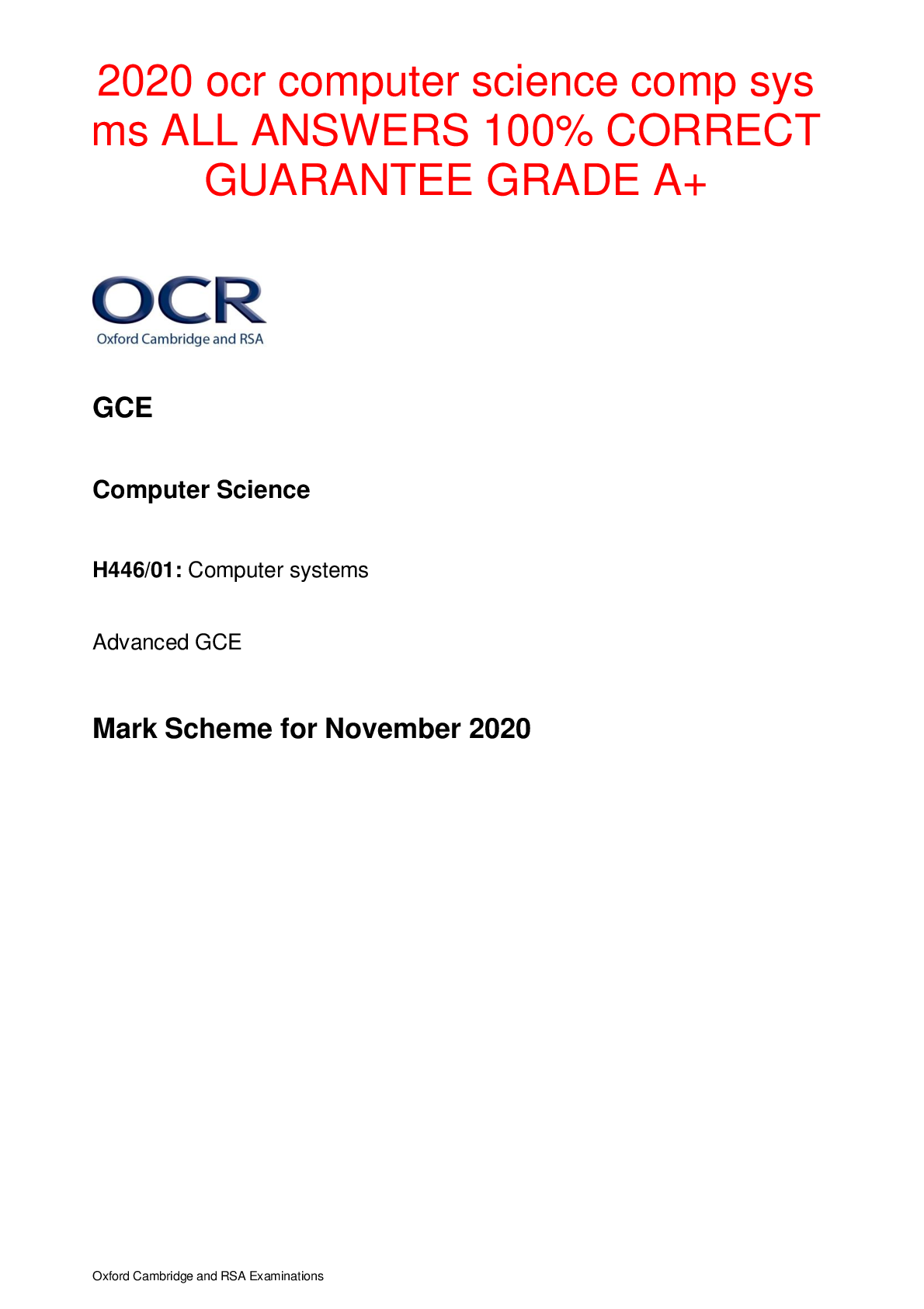
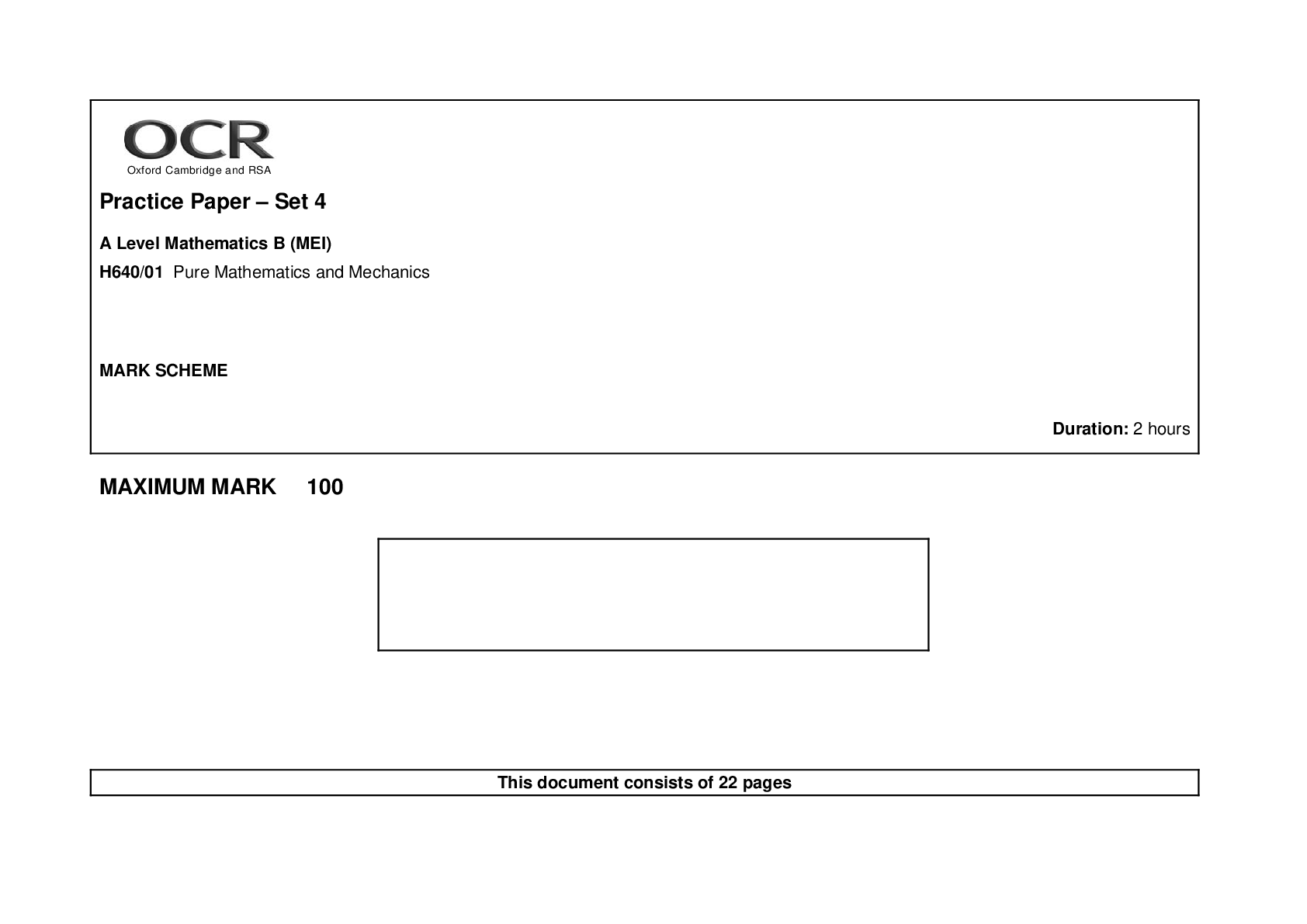
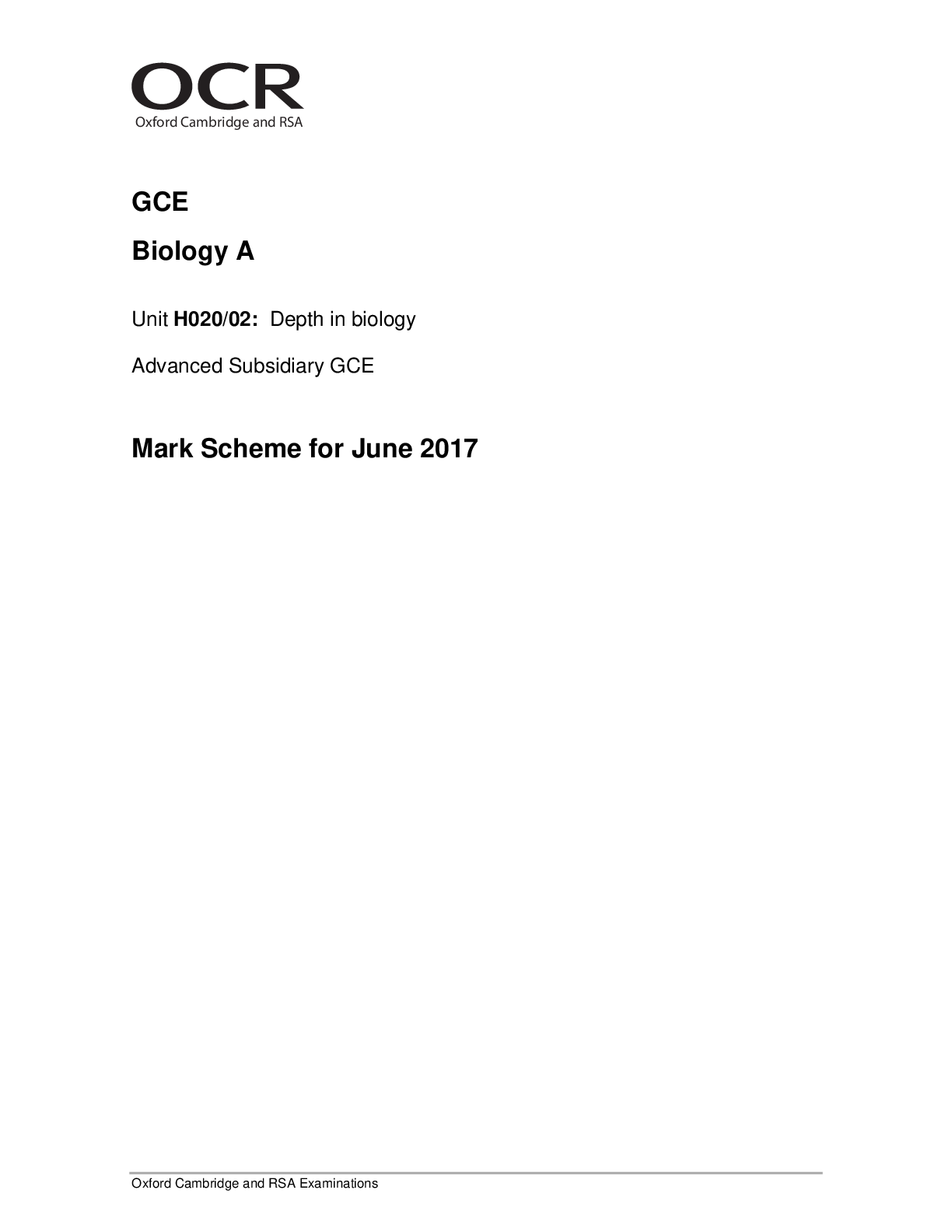


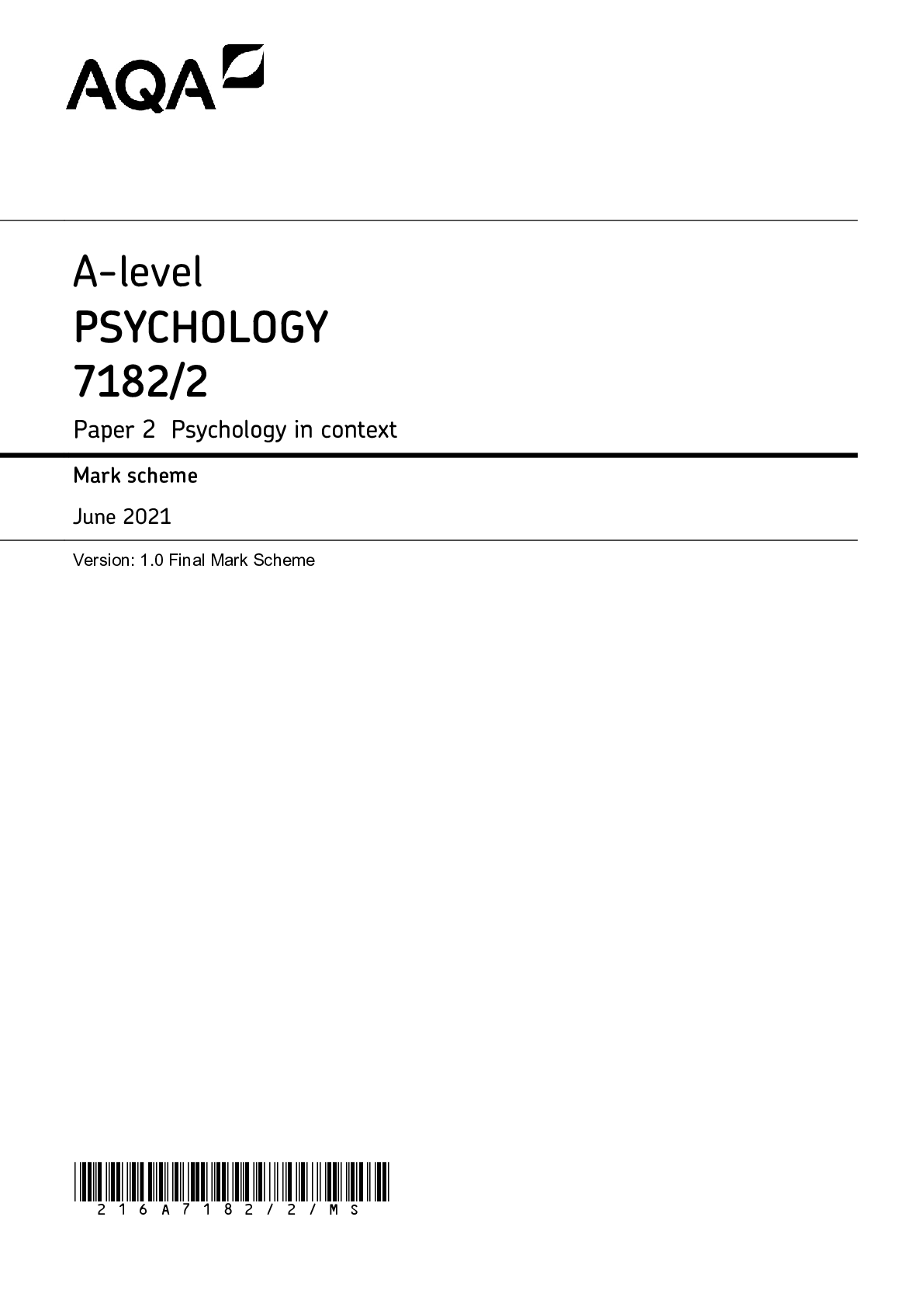
.png)
